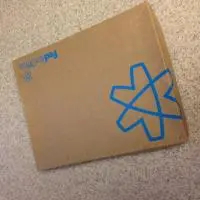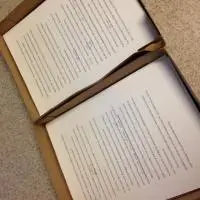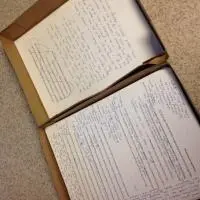There comes a time in every author's life when she picks up a printed copy of what, so far, she's only seen in pixels — a hard copy of the words she's worked so long and hard to craft.
It can be a beautiful moment — it really can — but it's also a moment that leads to more work. So much more work. So much work, I forget, each time, exactly how much more work this step can be.
My first time holding a paper copy of my own book came several months after I wrote the first draft of what would become the first book in my Undead America zombie series. I'd been hacking away at the story (it was about 70,000 words at the time) on various computer screens for months, and I was stuck. The story was suddenly as good as I could get it, but I knew, even then: it wasn't good enough. It finally occurred to me that I needed to see it on paper. I needed to hold it. I needed to see all the words in a form that I could attack with a pen. That I could draw all over. Dog-ear pages. Shake things up!
I had to print it out.
I remember holding it for the first time. I remember being blown away by it. "I wrote this?" I thought, staring at the neatly stacked pages. "But it's so big."
It was a really cool, really exciting feeling, and it happens (like new again) every time I print a book.
Of course, that gorgeous, clean, crisp sheaf of papers never lasts long in its pristine state. Within moments of picking it up, I'm off to the races, marking up my pages, often rewriting entire chapters as I go. Those lovely, white, crispy sheaves are soon folded over, marked up, with doodles and arrows and notes. It gets very ugly, very quickly, but the process of editing on paper is something I can't do without. Not if I want to be any sort of decent author. So that process is what we're talking about today — the great big Paper Project, as our next step in editing our books.
But first...hey you guys! How's it going? To those of you who've been working with me all through this crazy column: how are your books coming?
Me? Well, let's just say the last month has been a little hectic. A little crazy. A little....slow going, in terms of editing. Though I started my paper-edit with a bang, the day after my last editing column went live, well...since then life has intervened. It's the end of the school year, and my classroom volunteer/soccer mom jobs have taken precedence over my authorial work. I've taken entire weeks off as I've had to prepare for travel, for birthday parties (my little one turned seven), and for various other stuff.
In other words...I'm not done. Not even close.
BUT! Have no fear. I'm here to share what I've already done, what I've learned, and to hopefully tell you something or other that will help you to move forward, too! And this time...I have pictures!!
First off...how do you best print a manuscript, anyway?
This is actually a relevant question! You see, my printer and I....we're not friends. Not at all. Every time (every single time) I try to print something, be it photo or document, it tells me I'm out of a specific type of ink. Maybe it's the crimson one. Maybe it's the black one. It always gives me a specific ink type that I need to replace.
So what do I do? I go buy ink, of course. Then I come home, take out the old cartridge and replace it with the new one, all excited that this time, my document will print. I get back on my computer. I click the little printer icon.
And then? Well, then it tells me to replace another cartridge. I kid you not. My printer is always out of ink, no matter what I do. No matter how many times I replace it.
So when it comes time to print out a manuscript, I beat the system. I send that bad boy out to a printer.
I use FedEx Office (or FedEx Kinkos, or whatever they're calling it this month — it's changed a couple times since I created my account with them). It's a little spendy (averaging about $35.00 per printing), and their online UI for uploading can be pretty slow, but it's reliable, and I'm loyal. I upload my document, select my local store, and usually within an hour, I can go pick it up. It comes in a pretty little cardboard box, perfect for toting around during the editorial process. See?
 One tip: not every printer uses a pretty little box, or even an envelope, so be sure to protect your personal data if you're sending your document out for printing. Once I printed via UPS Store, as it was a couple bucks cheaper than FedEx. As per my usual, I had my cover page in the document, which included my name. My address. My phone number. So imagine my fury when I showed up at the UPS Store and there was my document, sitting out on the counter, ready for pickup, with absolutely nothing protecting it from the world. There it sat, cover page on top, address and phone number plain as day for anyone who wanted to steal my info.
One tip: not every printer uses a pretty little box, or even an envelope, so be sure to protect your personal data if you're sending your document out for printing. Once I printed via UPS Store, as it was a couple bucks cheaper than FedEx. As per my usual, I had my cover page in the document, which included my name. My address. My phone number. So imagine my fury when I showed up at the UPS Store and there was my document, sitting out on the counter, ready for pickup, with absolutely nothing protecting it from the world. There it sat, cover page on top, address and phone number plain as day for anyone who wanted to steal my info.
I wasn't happy. I lodged a complaint with their corporate office and everything. Since then I stick with the little cardboard box of FedEx. It's the sensible choice, as far as I'm concerned.
Now that I have the document, what the heck am I looking for?
For me, the paper edit is all about making things pretty. During prior writes and rewrites, I'm looking for structural changes...character flaws...major plot holes. But now? On paper? I'm looking at all the ways I can polish my writing to make it sparkly. Shiny. Beautiful. By the end of the paper edit, I want my words to look like rainbows pooped by unicorns.
On the paper edit, I care about word choice. Word order. I care about sentence structure, and finding my "crutch words" and crossing them ALL OUT. (Crutch words = those words you rely on, over and over again. For me, it's "toward" and "moment." If I see them on paper, I cross them out. All of them. Every single time. There's always at least fifty instances, on each paper edit I've done.)
On paper, you'll find me crossing out words and picking better ones. You'll find me drawing arrows from one paragraph to another, linking them together, helping the words find their flow. You'll find me adding notes in the margins, using asterisks to tell me where those words go, and using all those old editing symbols I learned somewhere back in middle school.
On this edit so far, some pages have barely gotten touched. Those are the pages I enjoy reading, where I sit back for a few minutes and think, "Hey, I can do this writing thing." They look like this:
 Other pages...well, more on those in a sec...
Other pages...well, more on those in a sec...
Because first we need to talk about...
Starting at the end — a first for me
I don't know if you remember this, but last month when I talked about the Dreadful First Rewrite, I mentioned that I'd made a big mistake: I spent so much time re-writing the first half of my book that by the time I hit the end, I flew through the final chapters, making so few changes I knew I must be missing something. I made myself a promise: on the paper edit, I'd start at the end, and see what I found.
What I found, when I followed through on that promise, starting at the final few chapters of my paper copy, was a mess. A ginormous mess. A mess that was so messy, I had to fight the urge to say "Forget it! This book is terrible and I never want to look at it again."
Yes. It was that bad.
But part of the fun of editing on paper is you can get a little creative in how you re-do your words, and on those final pages of my book....well, here's what two pages looked like when I was done with them:
 Nice, huh? But that's what I needed to do here, and that's what I did.
Nice, huh? But that's what I needed to do here, and that's what I did.
This is what I love about paper edits. Not only do you get to draw and scribble and doodle, but you get to see, at a glance, where you trouble spots are. There's accountability inherent in paper edits that doesn't exist on a computer screen (unless you use Track Changes, but who wants to do that? Because then you have to accept ALL the changes! UGH!). You get to flip through page after page, long after you're done, and re-live your mistakes. And by re-living them, you can finally learn how to fix them, hopefully in earlier drafts moving forward. It's a great way to advance your skills, and to keep learning how to be a better writer.
Because isn't that what we all want? To be better writers? I know I do! For me, editing on paper is always a huge step toward (crutch word!!) getting there.
Of course, after all these pages are hacked up, you get the fun job of translating your notes and inputting them into your manuscript. That job is tedious. Mindless. It kills me every time, but it's a necessary evil. So remember to write legibly enough that, when it's a month down the road and you're finally on the page again, you can figure out exactly what you meant to say. If you can't, all that time spent drawing arrows and adding notes was wasted, and you have to do it all over again.
But really, why am I not done yet? It's been a month for God's sake!
Editing...at least the good kind of editing...it takes time. As much as I'd love to be done with this book by now, as my husband always reminds me: some people take years to write a single book. The fact that I can write a book in just a few months is great, but sometimes, slowing down and really digging in makes all the difference in the world.
Or at least in the world of the book.
So I'm taking my time. I'm forcing myself to be patient. To care about each word, each sentence. If I don't, I know the story will suffer, and that's unacceptable.
What's next for this story?
After this edit is finally complete, I'll send my story out to a few betas. From them, I hope to hear where additional changes are needed. Where plot points aren't clear. Where characters aren't being true to themselves. Betas are another hugely important part of the editorial process, invaluable and imperative.
Then there will be another rewrite..and another...until, at some point, I send this story out into the world. Maybe someone will want to publish this weird little supernatural tale set during the Holocaust, and maybe not. But no matter what happens, it's all part of the process now, isn't it? Maybe I'll talk about that stuff when the time comes...but maybe I won't. Maybe you're tired of hearing me babble about process, month after month.
But enough about me...
Now it's your turn. For real this time. Fill me in! Tell me how you're doing! I'm dying to know! What are some things you've learned through editing on paper? What can you share?

About the author
Leah Rhyne is a Jersey girl who's lived in the South so long she's lost her accent...but never her attitude. After spending most of her childhood watching movies like Star Wars, Aliens, and A Nightmare On Elm Street, and reading books like Stephen King's The Shining or It, Leah now writes horror and science-fiction. She lives with her husband, daughter, and a small menagerie of pets.








